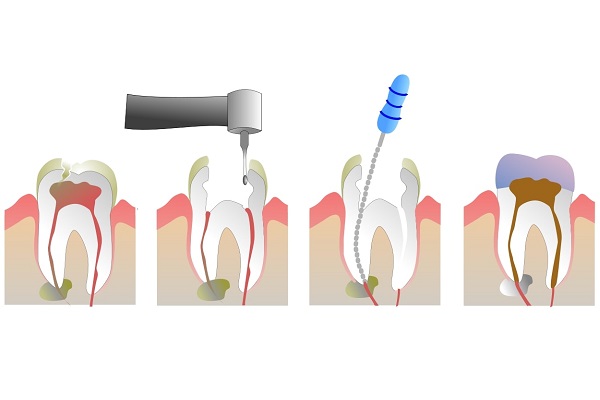Endodontic treatment normally entails a root canal. This procedure is designed to clear a tooth or gum of the infection that can generate more serious oral and general health problems. Sealing the canal constitutes a critical part of this process. In this article, we describe a gutta-percha root canal. This derives its name from the material used to fill and seal the canal. We explain the origin and properties of gutta-percha, how it is applied to patients undergoing root canal, and its advantages and drawbacks.

What Is Gutta-Percha Root Canal Filling?
Gutta-percha exists as a natural latex with its source in Palaquium Blanco and other trees growing throughout Southeast Asia. The material comes in solid and runny forms, otherwise known as Beta and Alpha. The temperature under which gutta-percha is exposed determines its state. At room temperature, gutta-percha assumes the Beta phase. This allows handlers to elongate and compact the material. The solid form is non-sticky and becomes brittle, or fragile, with age.
When temperatures reach 42 to 49 degrees Celsius, or approximately 108 to 120 degrees Fahrenheit, gutta-percha transforms to the Alpha phase. Here, gutta-percha becomes an adhesive and cannot be manipulated effectively.
What Is Gutta-Percha Used for?
Gutta-percha has a number of uses beyond the endodontic context. In the 19th century, golfers struck balls with gutta-percha throughout golf courses in Scotland and elsewhere. Currently, the material covers golf balls. Other non-dental purposes for gutta-percha include surgical equipment and various types of adhesives.
Its ability to become hard or soft with temperature changes, along with other properties, popularize gutta-percha as a root canal sealant. Specifically, endondontists apply it as filling for the opening left after a root canal. In performing a root canal, the endodontist creates an opening in the tooth which has become infected. The bacteria, sugar, and food particles are drained clean. The patient then gets a temporary filling to protect the opening from infectious invaders. On the return trip, the patient gets a permanent filling to complete the root canal procedure.

All stages of a root canal procedure, ending in restoration with gutta-percha filling.
5 Techniques for Using Gutta-Percha Root Canal Filling
- Cold Lateral Compaction. In this root canal filling procedure, the oral surgeon compacts gutta-percha points, or cones, sideways against the canal walls. This technique is widely used due to the relatively low cost of the instruments needed for it. For its ability to reduce expense, cold lateral compaction carries the problems of an incomplete filling in difficult to reach areas. This deficiency could ultimately generate more trips to the dentist or endodontist.
- Warm Lateral Compaction. As a potential answer to the problems of incomplete filling that comes with cold lateral compaction, the oral surgeon may apply heat during the lateral compaction. With Alpha properties, the gutta-percha is softer and can more easily be compacted for filling. However, excessive heat can melt the material and cause it to stick to the instrument that applies the gutta-percha rather than to the root canal for the treatment.
- Single Gutta-Percha Point and Sealer. Using a higher tapered cone, the surgeon performing a root canal can employ a single point and sealer to fill the opening. With simplicity, though, comes the problem that sealers often dissolve and that fluids may leak from the filling. The single gutta-percha point and sealer approach suits best those whose oral anatomy requires a custom-fitted cone.
- Vertical Compaction. In its Beta manifestation, gutta-percha can flow fairly well into the canals. Vertical compaction can amplify the effectiveness of this filling. However, the procedure requires more time and skill than other processes because the gutta-percha is applied in increments rather than at one time.
- Injections. Some endodontists have turned to a glue gun type machine to inject pellets of gutta-percha. These small pieces are softened at temperatures near 392 degrees Fahrenheit (200 degrees Celsius). A heated silver needle pushes the gutta-percha into the canal.
Advantages and Disadvantages of Gutta-Percha Filling
Advantages
- Endodontists draw to a gutta-percha root canal for the ease of handling the material.
- It is inert, which means it does not generally move on its own.
- Gutta-percha reacts readily to heat, becoming plastic-like and sticky when hot.
- Gutta-percha has high visibility on x-rays. This allows the dentist or oral surgeon to notice inadequacies in the effectiveness of the filling.
- Thanks to its properties, gutta-percha can be easily removed when necessary.
Disadvantages
This material, though, has its detractors and carries some pitfalls:
- Gutta-percha does not adhere very well.
- When age causes it to become brittle, it can fall apart.
- Pressure can easily displace gutta-percha, causing a loss of the filling.
- The length is difficult to control.
Gutta-Percha Root Canal Filling Alternative
To address some of the problems of gutta-percha, those in the dental community have explored alternatives. One such alternative is resilon. This proffered replacement for gutta-percha bonds to sealers through a process known as polymerization. This chemical reaction creates large molecules out of two or more smaller ones. Resilons such as RealSeal and EndoREZ possess the same radiographic characteristics as gutta-percha.
Conclusion
The selection of a root canal filling is a major factor in the success of endodontic treatment. Such a decision cannot be left to convenience and cost. The material must be able to seal the canal against foreign invaders. Otherwise, the patient may face repeated or even more extensive and irreversible treatment. A gutta-percha root canal has many qualities that offer convenience, but it may ultimately undermine the purpose of the root canal. If you have any experience with gutta-percha root canal, share it down below.

Leave a Comment